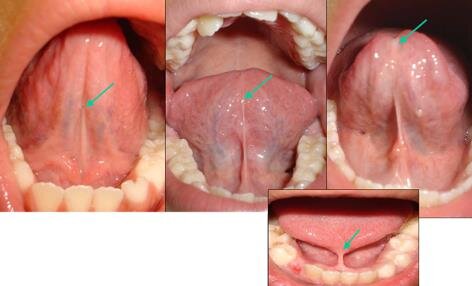Tongue Tie¶
A tongue tie, also known as ankyloglossia, is a condition where the band of tissue under the tongue (the lingual frenulum) is unusually tight, short, or thick. This can restrict the natural movement of the tongue, impacting everything from feeding and speech to breathing and facial development.
Tongue ties are more common than many people realize — and their effects can last well beyond infancy.

The band of connective tissue underneath the tongue is called a lingual frenulum. If this frenulum is too tight, too thick, too short and ultimately too restrictive, as well as causing functional issues then you may have a tongue tie.
What Does the Tongue Need to Do?¶
The tongue plays a vital role in many essential functions, including:
- Breastfeeding and bottle-feeding
- Swallowing
- Chewing
- Speaking clearly
- Maintaining proper oral rest posture
- Supporting nasal breathing and airway health
For the tongue to function properly, it needs to move freely — especially upward to rest on the roof of the mouth. A tongue tie can prevent this natural movement, leading to compensations in the mouth, face, and body.
Signs and Symptoms of a Tongue Tie¶
In Babies:¶
- Difficulty latching or prolonged feeding times
- Clicking noises during nursing
- Poor weight gain
- Gassiness or reflux symptoms
- Maternal nipple pain or damage
In Children and Adults:¶
- Speech delays or articulation issues
- Mouth breathing
- Snoring or disturbed sleep
- Trouble licking lips or an ice cream cone
- Difficulty swallowing pills or certain foods
- Orthodontic problems (e.g., open bite, narrow palate)
- Chronic tension in the jaw or neck
Even in adults, untreated tongue ties can lead to dysfunction and discomfort that myofunctional therapy can help resolve.
How a Tongue Tie Is Assessed¶
Assessing a tongue tie involves more than just looking under the tongue — it's about understanding how well the tongue can function in everyday activities like eating, speaking, swallowing, and breathing.
At our practice, we perform a functional oral assessment to determine if a tongue tie is impacting your or your child’s health. We look at several key areas:
1. Tongue Mobility¶
We check how well the tongue can move:
- Up toward the palate
- Side to side
- Forward beyond the lips
- Without compensating with the jaw or floor of the mouth
Restricted movement may indicate a functional tie.
2. Tongue Posture¶
We evaluate where the tongue naturally rests — ideally, it should sit gently against the roof of the mouth when not in use. A restricted tongue often rests low and forward.
3. Swallowing Patterns¶
We observe how the tongue functions during swallowing. A tongue tie may cause:
- A tongue thrust pattern
- Overuse of facial or jaw muscles
- Difficulty managing certain textures or sizes of food
4. Speech and Oral Habits¶
Speech clarity, articulation, and oral habits (like thumb sucking, mouth breathing, or bruxism) are also considered, especially in children.
5. Compensations¶
We look for signs of the body adapting around the restriction — like excessive use of the lips or jaw to compensate for limited tongue movement. These patterns can mask a tongue tie and often lead to further dysfunction.
Appearance Matters, But Function Matters More¶
Some tongue ties are easy to spot — a tight, visible band of tissue under the tongue. Others are more subtle, commonly called posterior tongue ties, but also known as mid tongue restrictions, which can still cause major issues despite looking "normal."
That’s why we focus on function. A tongue tie is only considered problematic if it’s limiting what the tongue needs to do — not just because it looks tight.
How Is a Tongue Tie Treated?¶
Tongue tie treatment typically involves a frenectomy — a procedure to release the restrictive tissue. This can be done by a trained provider using scissors, a laser, or other tools.
However, surgery alone is not a complete solution.
The Role of Myofunctional Therapy¶
Myofunctional therapy is essential before and after a tongue tie release. It helps to:
- Prepare the tongue and surrounding muscles for proper function
- Reduce compensation patterns (like using the lips or jaw instead of the tongue)
- Support healing after the procedure
- Establish new habits for tongue posture, breathing, and swallowing
Without therapy, the tongue may not gain full function, or the tissue may reattach improperly. We work closely with release providers to ensure the best outcome for each client.
Do All Tongue Ties Need to Be Released?¶
Not necessarily. The decision to release a tongue tie depends on function, not just appearance. Some ties look severe but don’t cause any symptoms — while others may be subtle but lead to significant dysfunction.
A thorough functional assessment by a myofunctional therapist can help determine whether therapy alone is sufficient, or if a release may be beneficial.
We’re Here to Help¶
If you or your child has been told there may be a tongue tie — or you're noticing symptoms that could be related — a myofunctional evaluation is a great place to start. We’ll assess tongue mobility, strength, posture, and function to create a personalized plan that supports long-term health and comfort.